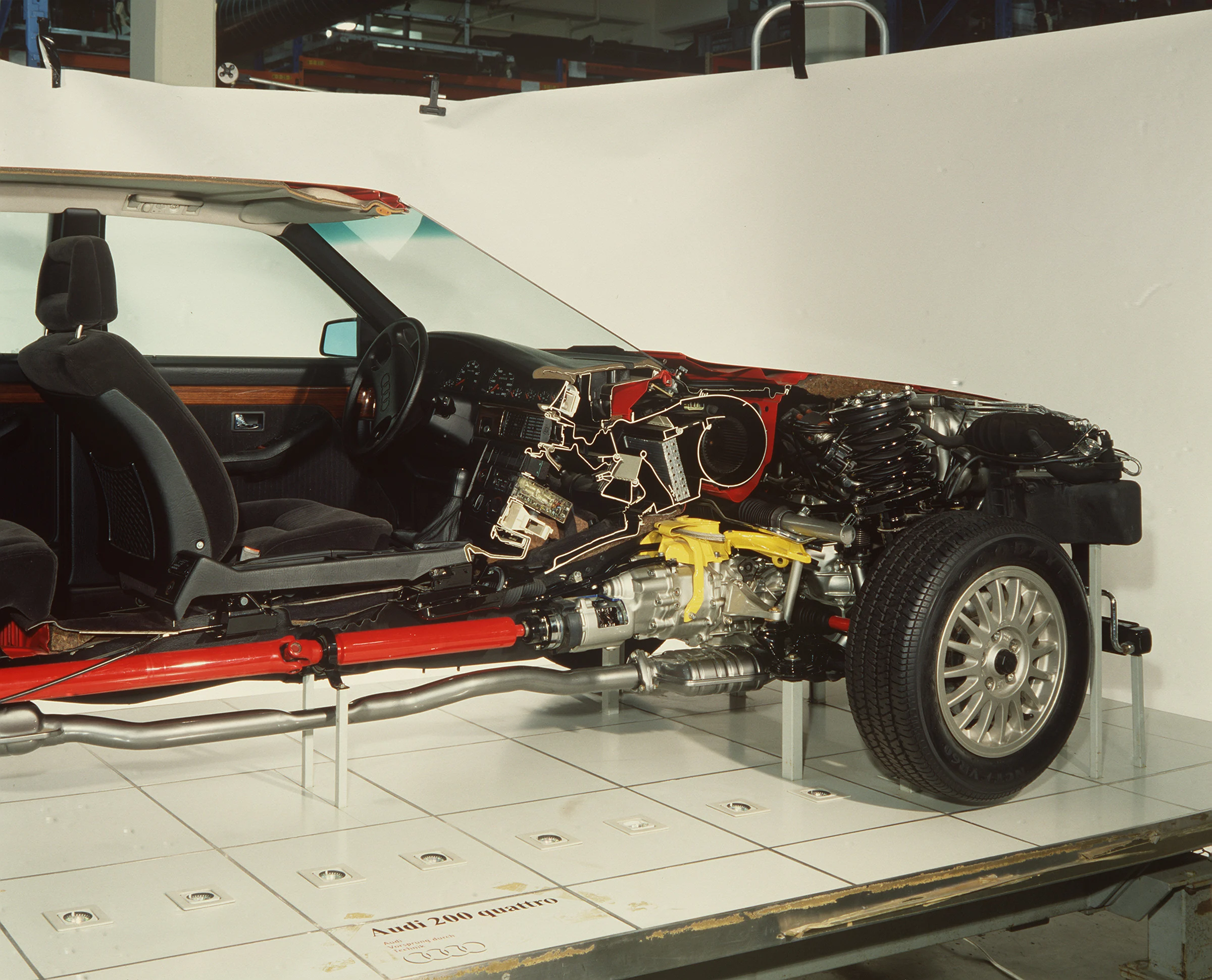← Audi 200 Turbo
1986

Physical Description
Sectioned automobile, full size, Audi 200 Turbo, metal/plastic/rubber, made and sectioned by Auto Union GmbH, Germany, 1986, imported into Australia by TKM Automotive Australia Pty Ltd for display at Australian motor shows. This four-door, Audi 200 Turbo, left-hand drive sedan is painted red in colour and is sectioned at the mid-point. The removal of the right-side bodywork exposes the right-hand mechanisms, thereby allowing visual access to the interior of the vehicle. This car consists of an inline overhead camshaft, and a 5-cylinder, turbocharged engine, capable of providing traction through the Audi-designed 'Quattro' all-wheel-drive mechanism. The car is mounted on a display platform supported by a steel sub-frame.
Object Statement
Sectioned automobile, full size, Audi 200 Turbo, metal/plastic/rubber, made and sectioned by Auto Union GmbH, Germany, 1986, imported into Australia by TKM Automotive Australia Pty Ltd for display at Australian motor shows
History
Apparently sectioned in Germany for use at European motor shows. Brought to Australia by TKM Automotive P/L for display at Australian motor shows. Originally owned by Auto Union GmbH, Germany and Acquired by TKM Automotive P/L.
Dimensions
- Width: 2000 mm
Production
The Audi company, or more correctly the Horch Werke Company, later renamed Auto Union GmbH, was established in 1909 by August Horch (1868-1951) in Zwickau, Germany. Horch was an automotive engineer who began his career by joining Carl Benz in Mannheim where until 1899 he was in charge of the Benz company's engine manufacturing plant and later vehicle construction, overseeing and contributing to the development of the motor vehicle during its earliest days. Horch's first automobile repair workshop, Horch & Cie Motorwagen Werke, was established in Cologne in 1899 and would be the site of Horchs' first assembled car in 1901. Eight years later, differences of opinion between Horch and members of the company's supervisory board forced him to leave the company. He then established the Zwichau workshops in 1909. Since his own name was protected by trademark, in 1910 Horch renamed his new business, Audi, or more accurately Audi Automobilewerke GmbH, a Latin translation of his own name, meaning hark or listen.
The Audi emblem, with its four rings, is identified as one of Germany's oldest-established manufacturers of prestige motorcars. Each ring symbolises the 1932 amalgamation of four previously-independent motor-vehicle manufacturers: Audi, DKW, Horch and Wanderer and the formation of what is known today (2018) as AUDI AG. However, it was August Horch who was responsible for laying the groundwork of the firm. Throughout his career Horch broke new ground and engaged in new technologies. In 1920 he was the first to use an oil-wetted air cleaner and a four-wheel braking system. It was his approach to automobile production which had captured the attention of the DKW Company.
The DKW Company, an acronym for Dampf Kraft Wagen, (the German term for steam-driven engine) were known for their production of motorcycles and were keen to expand their business into the manufacture of smaller vehicles. DKW's driving force, Jotgen Skafte Rasmussen, was looking beyond the company's manufacture of steam-driven vehicles to the more popular and lucrative two-stroke engines noted for their durability and handling, firstly on bicycles and then on motorcycles. It would be Rasmussen's idea of employing two-stroke engines in small cars, which had resulted in DKW forming an association with Audi Werke AG. In 1928 Rasmussen developed this relationship by acquiring a majority of Audi Werke AG shares and later consolidating and purchasing the remaining shares the following decade.
In 1930, under the direction of Rasmussen, DKW commissioned Audi to develop a vehicle featuring a two-stroke engine. The final product was a vehicle called the DKW Front, which was launched at the Berlin Motor Show in 1931. Hailed as a success by both critics and the public alike, the DKW Front went on to become the most popular German car of its time. It was called the 'Front' due to its front-wheel-drive system which comprised swing axles, a chassis constructed from wood and a 'beefed up' version of the two-stroke DKW motorcycle engine. Inevitably, DKW bought the controlling interest in Audi and during increasingly difficult economic times, the Horch company found themselves in the tenuous position in which an amalgamation with DKW was the only way of continuing its operation.